Management Case Study: Challenge the Boss or Stand Down? Analysis
VerifiedAdded on 2020/05/16
|10
|2288
|287
Case Study
AI Summary
This case study analyzes the management issues arising from a conflict between a boss and a subordinate, exploring topics such as behavioral conflict, lack of understanding of roles, and misuse of power. The analysis delves into the impact of these issues on organizational productivity and employee motivation. It applies motivational theories like ERG, Acquired Needs, and Herzberg's Two-Factor Theory, along with Human Resource models such as the Harvard and AMO models, to understand the dynamics at play. Furthermore, the study examines leadership theories including Trait and Transformational theories to evaluate the leader's role in resolving the conflict. The study concludes with a discussion on how the boss can motivate the subordinate and create a more productive work environment. The document references various sources to support its analysis.
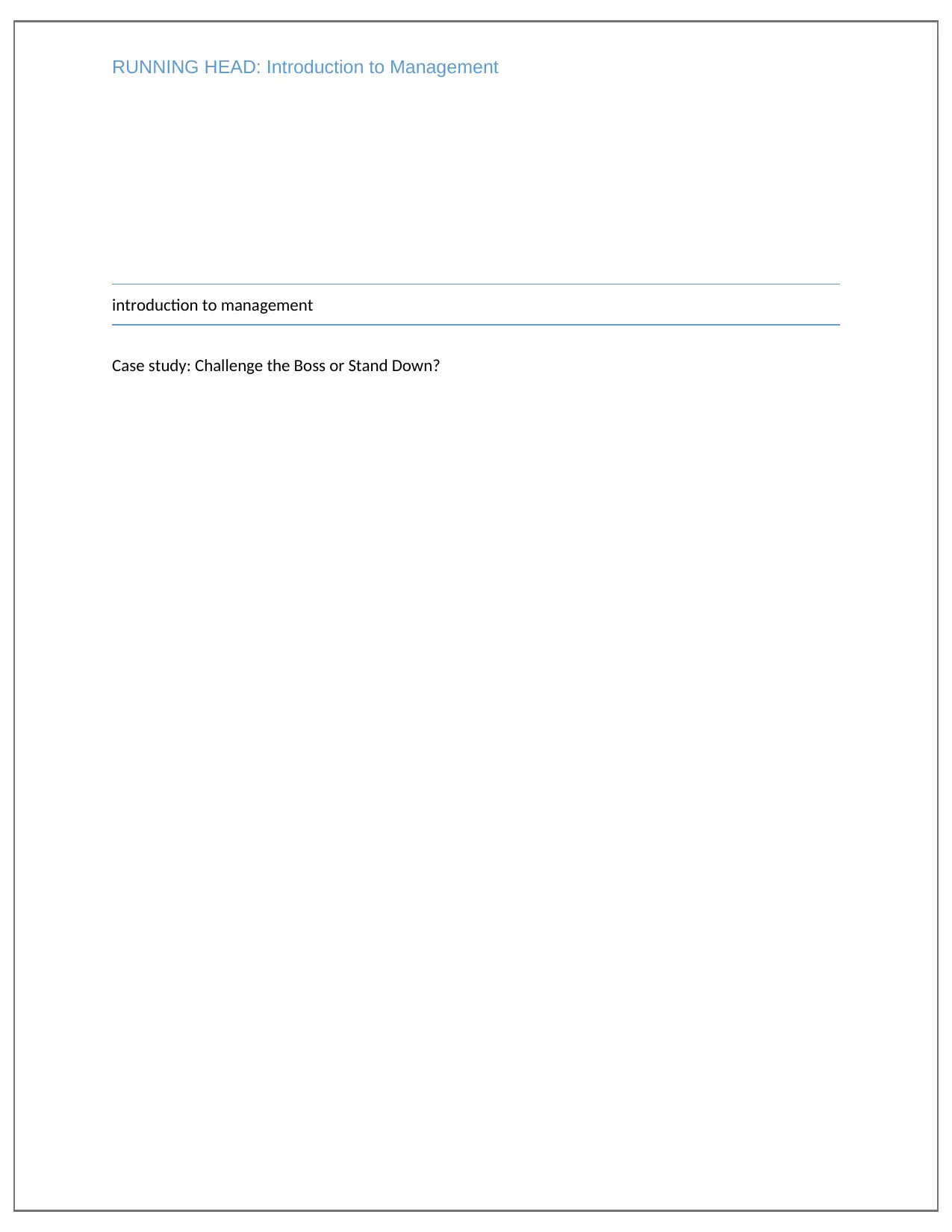
RUNNING HEAD: Introduction to Management
introduction to management
Case study: Challenge the Boss or Stand Down?
introduction to management
Case study: Challenge the Boss or Stand Down?
Paraphrase This Document
Need a fresh take? Get an instant paraphrase of this document with our AI Paraphraser
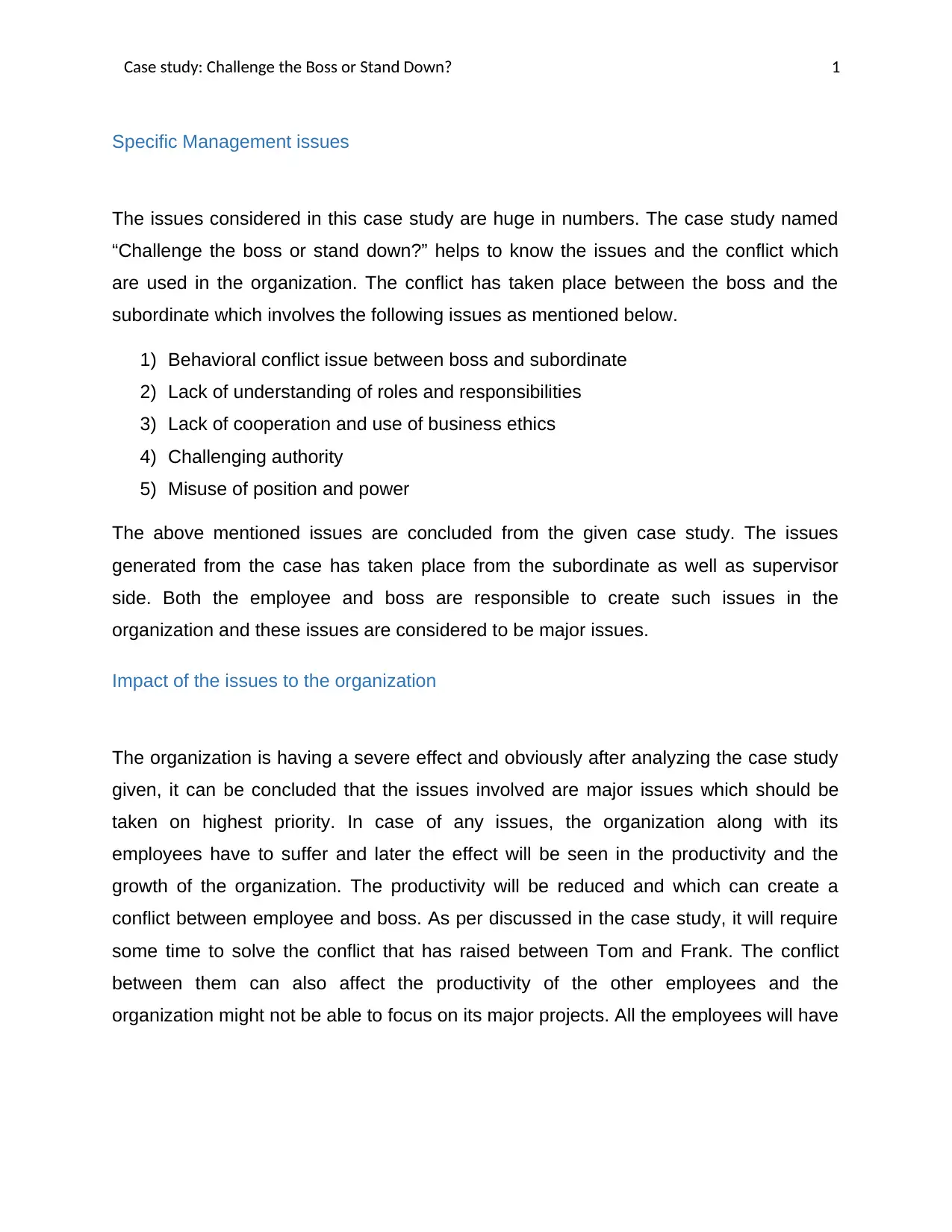
Case study: Challenge the Boss or Stand Down? 1
Specific Management issues
The issues considered in this case study are huge in numbers. The case study named
“Challenge the boss or stand down?” helps to know the issues and the conflict which
are used in the organization. The conflict has taken place between the boss and the
subordinate which involves the following issues as mentioned below.
1) Behavioral conflict issue between boss and subordinate
2) Lack of understanding of roles and responsibilities
3) Lack of cooperation and use of business ethics
4) Challenging authority
5) Misuse of position and power
The above mentioned issues are concluded from the given case study. The issues
generated from the case has taken place from the subordinate as well as supervisor
side. Both the employee and boss are responsible to create such issues in the
organization and these issues are considered to be major issues.
Impact of the issues to the organization
The organization is having a severe effect and obviously after analyzing the case study
given, it can be concluded that the issues involved are major issues which should be
taken on highest priority. In case of any issues, the organization along with its
employees have to suffer and later the effect will be seen in the productivity and the
growth of the organization. The productivity will be reduced and which can create a
conflict between employee and boss. As per discussed in the case study, it will require
some time to solve the conflict that has raised between Tom and Frank. The conflict
between them can also affect the productivity of the other employees and the
organization might not be able to focus on its major projects. All the employees will have
Specific Management issues
The issues considered in this case study are huge in numbers. The case study named
“Challenge the boss or stand down?” helps to know the issues and the conflict which
are used in the organization. The conflict has taken place between the boss and the
subordinate which involves the following issues as mentioned below.
1) Behavioral conflict issue between boss and subordinate
2) Lack of understanding of roles and responsibilities
3) Lack of cooperation and use of business ethics
4) Challenging authority
5) Misuse of position and power
The above mentioned issues are concluded from the given case study. The issues
generated from the case has taken place from the subordinate as well as supervisor
side. Both the employee and boss are responsible to create such issues in the
organization and these issues are considered to be major issues.
Impact of the issues to the organization
The organization is having a severe effect and obviously after analyzing the case study
given, it can be concluded that the issues involved are major issues which should be
taken on highest priority. In case of any issues, the organization along with its
employees have to suffer and later the effect will be seen in the productivity and the
growth of the organization. The productivity will be reduced and which can create a
conflict between employee and boss. As per discussed in the case study, it will require
some time to solve the conflict that has raised between Tom and Frank. The conflict
between them can also affect the productivity of the other employees and the
organization might not be able to focus on its major projects. All the employees will have
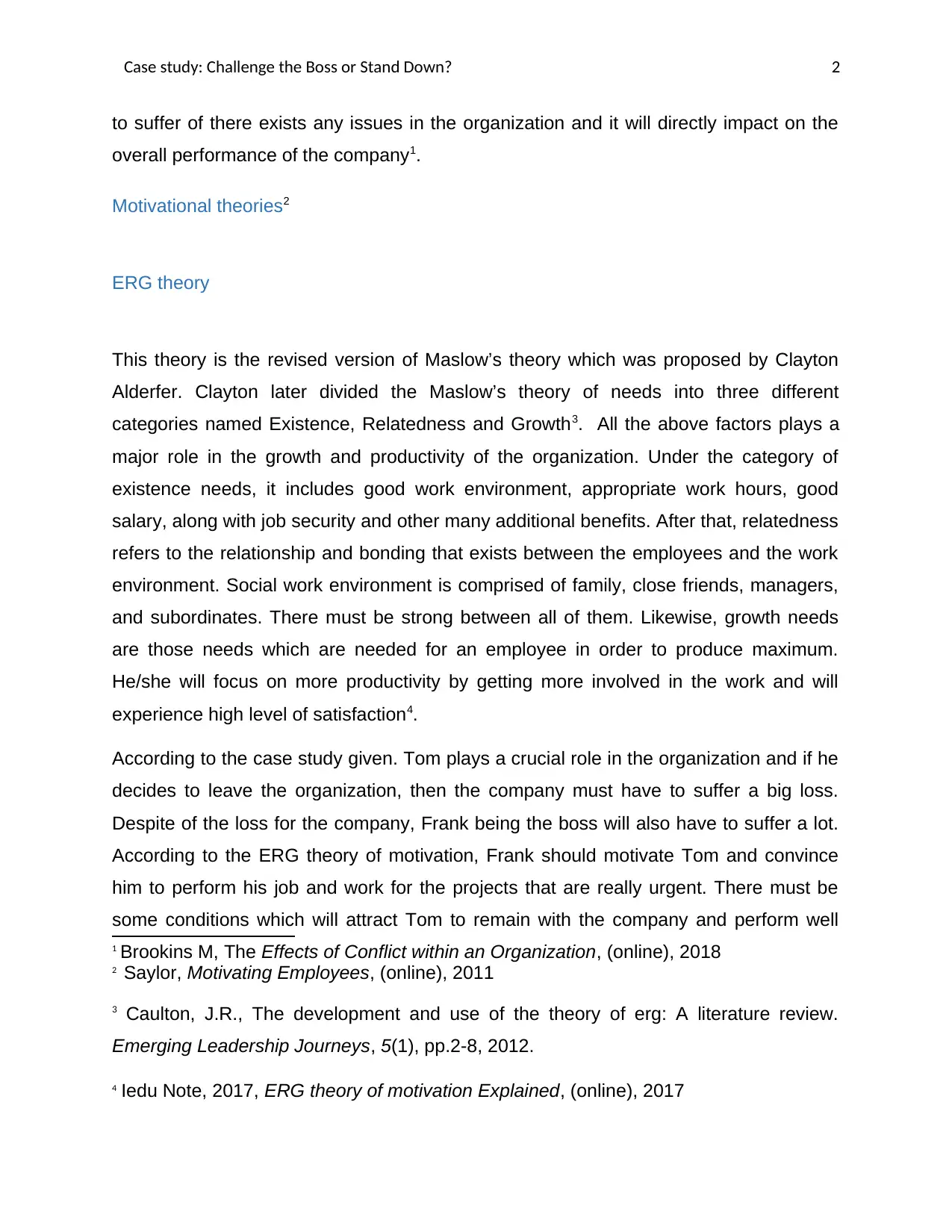
Case study: Challenge the Boss or Stand Down? 2
to suffer of there exists any issues in the organization and it will directly impact on the
overall performance of the company1.
Motivational theories2
ERG theory
This theory is the revised version of Maslow’s theory which was proposed by Clayton
Alderfer. Clayton later divided the Maslow’s theory of needs into three different
categories named Existence, Relatedness and Growth3. All the above factors plays a
major role in the growth and productivity of the organization. Under the category of
existence needs, it includes good work environment, appropriate work hours, good
salary, along with job security and other many additional benefits. After that, relatedness
refers to the relationship and bonding that exists between the employees and the work
environment. Social work environment is comprised of family, close friends, managers,
and subordinates. There must be strong between all of them. Likewise, growth needs
are those needs which are needed for an employee in order to produce maximum.
He/she will focus on more productivity by getting more involved in the work and will
experience high level of satisfaction4.
According to the case study given. Tom plays a crucial role in the organization and if he
decides to leave the organization, then the company must have to suffer a big loss.
Despite of the loss for the company, Frank being the boss will also have to suffer a lot.
According to the ERG theory of motivation, Frank should motivate Tom and convince
him to perform his job and work for the projects that are really urgent. There must be
some conditions which will attract Tom to remain with the company and perform well
1 Brookins M, The Effects of Conflict within an Organization, (online), 2018
2 Saylor, Motivating Employees, (online), 2011
3 Caulton, J.R., The development and use of the theory of erg: A literature review.
Emerging Leadership Journeys, 5(1), pp.2-8, 2012.
4 Iedu Note, 2017, ERG theory of motivation Explained, (online), 2017
to suffer of there exists any issues in the organization and it will directly impact on the
overall performance of the company1.
Motivational theories2
ERG theory
This theory is the revised version of Maslow’s theory which was proposed by Clayton
Alderfer. Clayton later divided the Maslow’s theory of needs into three different
categories named Existence, Relatedness and Growth3. All the above factors plays a
major role in the growth and productivity of the organization. Under the category of
existence needs, it includes good work environment, appropriate work hours, good
salary, along with job security and other many additional benefits. After that, relatedness
refers to the relationship and bonding that exists between the employees and the work
environment. Social work environment is comprised of family, close friends, managers,
and subordinates. There must be strong between all of them. Likewise, growth needs
are those needs which are needed for an employee in order to produce maximum.
He/she will focus on more productivity by getting more involved in the work and will
experience high level of satisfaction4.
According to the case study given. Tom plays a crucial role in the organization and if he
decides to leave the organization, then the company must have to suffer a big loss.
Despite of the loss for the company, Frank being the boss will also have to suffer a lot.
According to the ERG theory of motivation, Frank should motivate Tom and convince
him to perform his job and work for the projects that are really urgent. There must be
some conditions which will attract Tom to remain with the company and perform well
1 Brookins M, The Effects of Conflict within an Organization, (online), 2018
2 Saylor, Motivating Employees, (online), 2011
3 Caulton, J.R., The development and use of the theory of erg: A literature review.
Emerging Leadership Journeys, 5(1), pp.2-8, 2012.
4 Iedu Note, 2017, ERG theory of motivation Explained, (online), 2017
⊘ This is a preview!⊘
Do you want full access?
Subscribe today to unlock all pages.

Trusted by 1+ million students worldwide
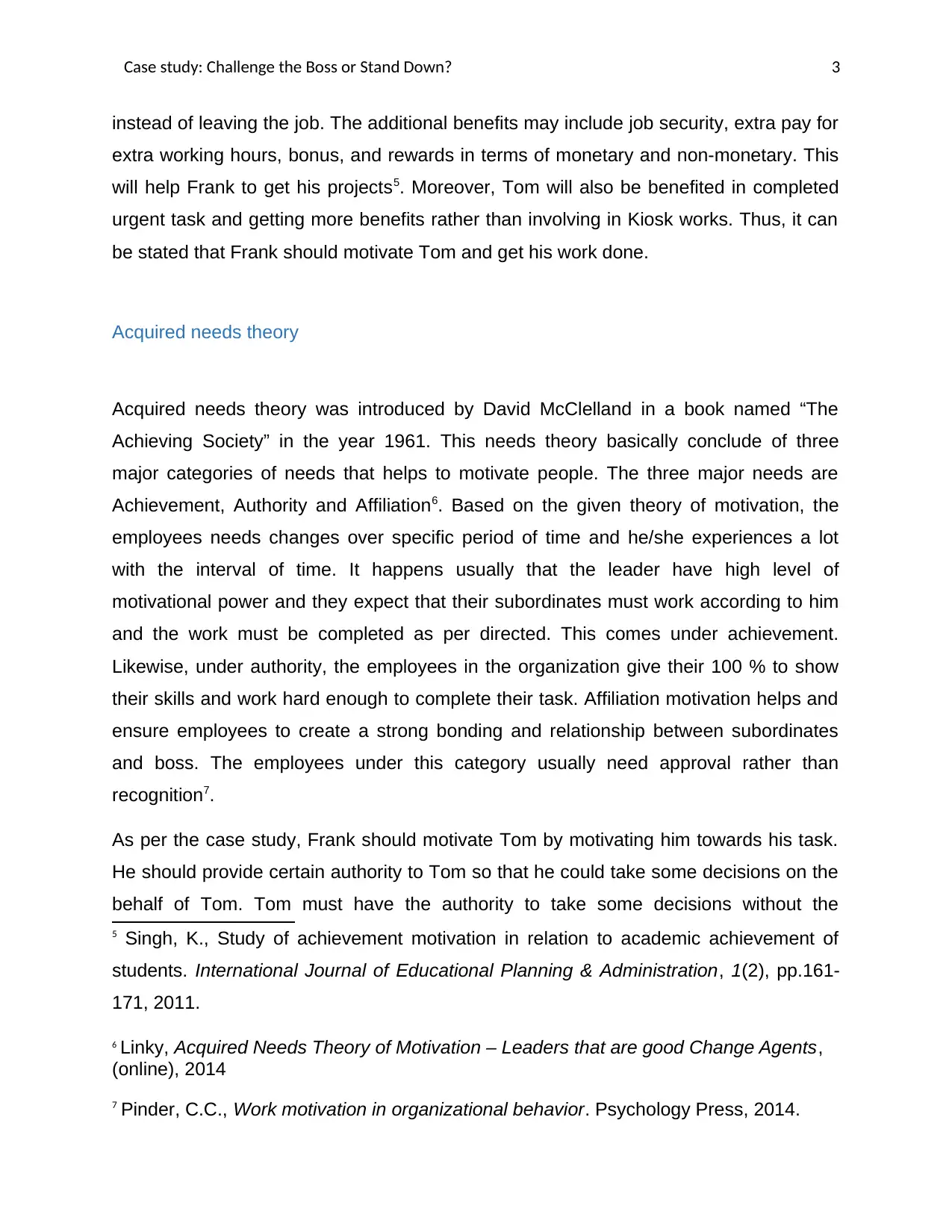
Case study: Challenge the Boss or Stand Down? 3
instead of leaving the job. The additional benefits may include job security, extra pay for
extra working hours, bonus, and rewards in terms of monetary and non-monetary. This
will help Frank to get his projects5. Moreover, Tom will also be benefited in completed
urgent task and getting more benefits rather than involving in Kiosk works. Thus, it can
be stated that Frank should motivate Tom and get his work done.
Acquired needs theory
Acquired needs theory was introduced by David McClelland in a book named “The
Achieving Society” in the year 1961. This needs theory basically conclude of three
major categories of needs that helps to motivate people. The three major needs are
Achievement, Authority and Affiliation6. Based on the given theory of motivation, the
employees needs changes over specific period of time and he/she experiences a lot
with the interval of time. It happens usually that the leader have high level of
motivational power and they expect that their subordinates must work according to him
and the work must be completed as per directed. This comes under achievement.
Likewise, under authority, the employees in the organization give their 100 % to show
their skills and work hard enough to complete their task. Affiliation motivation helps and
ensure employees to create a strong bonding and relationship between subordinates
and boss. The employees under this category usually need approval rather than
recognition7.
As per the case study, Frank should motivate Tom by motivating him towards his task.
He should provide certain authority to Tom so that he could take some decisions on the
behalf of Tom. Tom must have the authority to take some decisions without the
5 Singh, K., Study of achievement motivation in relation to academic achievement of
students. International Journal of Educational Planning & Administration, 1(2), pp.161-
171, 2011.
6 Linky, Acquired Needs Theory of Motivation – Leaders that are good Change Agents,
(online), 2014
7 Pinder, C.C., Work motivation in organizational behavior. Psychology Press, 2014.
instead of leaving the job. The additional benefits may include job security, extra pay for
extra working hours, bonus, and rewards in terms of monetary and non-monetary. This
will help Frank to get his projects5. Moreover, Tom will also be benefited in completed
urgent task and getting more benefits rather than involving in Kiosk works. Thus, it can
be stated that Frank should motivate Tom and get his work done.
Acquired needs theory
Acquired needs theory was introduced by David McClelland in a book named “The
Achieving Society” in the year 1961. This needs theory basically conclude of three
major categories of needs that helps to motivate people. The three major needs are
Achievement, Authority and Affiliation6. Based on the given theory of motivation, the
employees needs changes over specific period of time and he/she experiences a lot
with the interval of time. It happens usually that the leader have high level of
motivational power and they expect that their subordinates must work according to him
and the work must be completed as per directed. This comes under achievement.
Likewise, under authority, the employees in the organization give their 100 % to show
their skills and work hard enough to complete their task. Affiliation motivation helps and
ensure employees to create a strong bonding and relationship between subordinates
and boss. The employees under this category usually need approval rather than
recognition7.
As per the case study, Frank should motivate Tom by motivating him towards his task.
He should provide certain authority to Tom so that he could take some decisions on the
behalf of Tom. Tom must have the authority to take some decisions without the
5 Singh, K., Study of achievement motivation in relation to academic achievement of
students. International Journal of Educational Planning & Administration, 1(2), pp.161-
171, 2011.
6 Linky, Acquired Needs Theory of Motivation – Leaders that are good Change Agents,
(online), 2014
7 Pinder, C.C., Work motivation in organizational behavior. Psychology Press, 2014.
Paraphrase This Document
Need a fresh take? Get an instant paraphrase of this document with our AI Paraphraser
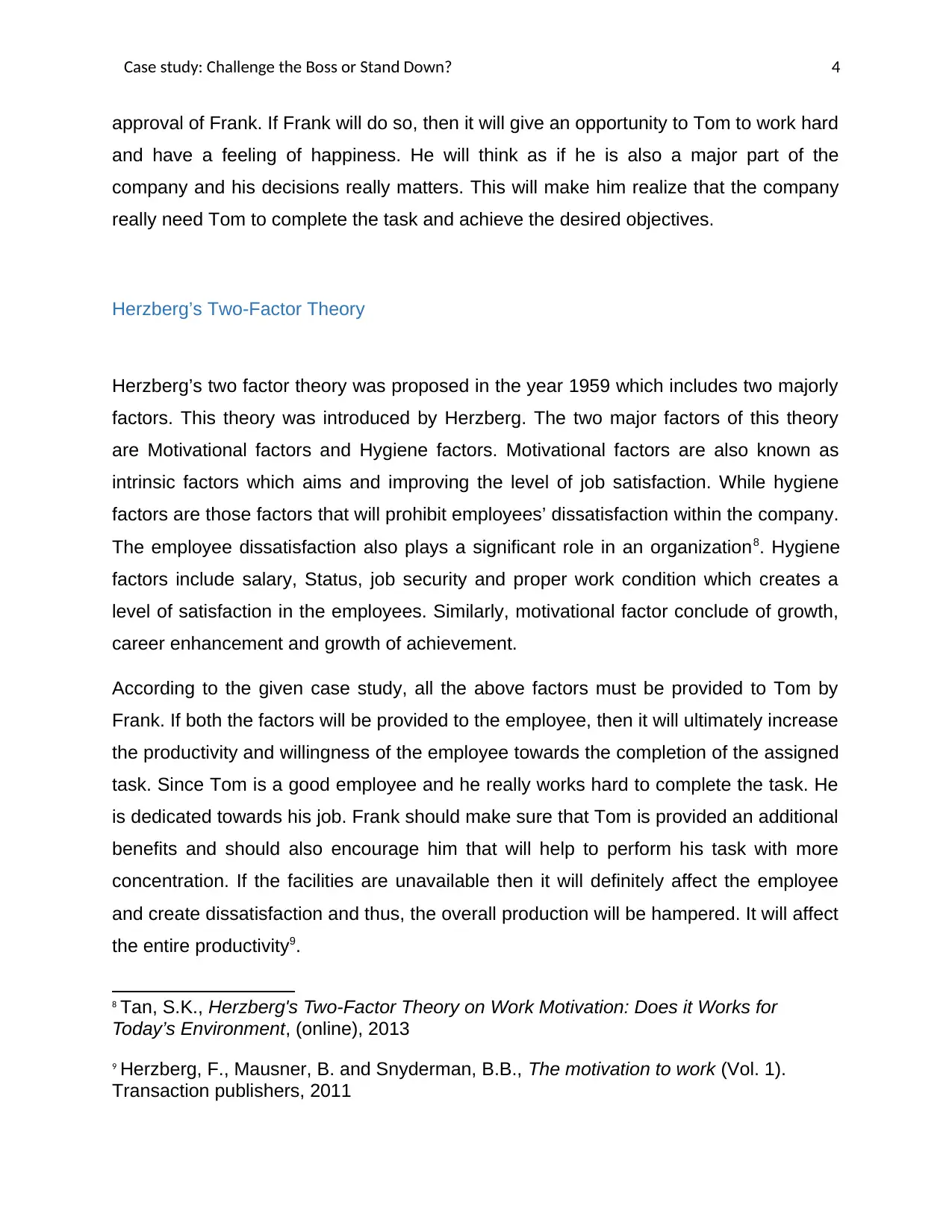
Case study: Challenge the Boss or Stand Down? 4
approval of Frank. If Frank will do so, then it will give an opportunity to Tom to work hard
and have a feeling of happiness. He will think as if he is also a major part of the
company and his decisions really matters. This will make him realize that the company
really need Tom to complete the task and achieve the desired objectives.
Herzberg’s Two-Factor Theory
Herzberg’s two factor theory was proposed in the year 1959 which includes two majorly
factors. This theory was introduced by Herzberg. The two major factors of this theory
are Motivational factors and Hygiene factors. Motivational factors are also known as
intrinsic factors which aims and improving the level of job satisfaction. While hygiene
factors are those factors that will prohibit employees’ dissatisfaction within the company.
The employee dissatisfaction also plays a significant role in an organization8. Hygiene
factors include salary, Status, job security and proper work condition which creates a
level of satisfaction in the employees. Similarly, motivational factor conclude of growth,
career enhancement and growth of achievement.
According to the given case study, all the above factors must be provided to Tom by
Frank. If both the factors will be provided to the employee, then it will ultimately increase
the productivity and willingness of the employee towards the completion of the assigned
task. Since Tom is a good employee and he really works hard to complete the task. He
is dedicated towards his job. Frank should make sure that Tom is provided an additional
benefits and should also encourage him that will help to perform his task with more
concentration. If the facilities are unavailable then it will definitely affect the employee
and create dissatisfaction and thus, the overall production will be hampered. It will affect
the entire productivity9.
8 Tan, S.K., Herzberg's Two-Factor Theory on Work Motivation: Does it Works for
Today’s Environment, (online), 2013
9 Herzberg, F., Mausner, B. and Snyderman, B.B., The motivation to work (Vol. 1).
Transaction publishers, 2011
approval of Frank. If Frank will do so, then it will give an opportunity to Tom to work hard
and have a feeling of happiness. He will think as if he is also a major part of the
company and his decisions really matters. This will make him realize that the company
really need Tom to complete the task and achieve the desired objectives.
Herzberg’s Two-Factor Theory
Herzberg’s two factor theory was proposed in the year 1959 which includes two majorly
factors. This theory was introduced by Herzberg. The two major factors of this theory
are Motivational factors and Hygiene factors. Motivational factors are also known as
intrinsic factors which aims and improving the level of job satisfaction. While hygiene
factors are those factors that will prohibit employees’ dissatisfaction within the company.
The employee dissatisfaction also plays a significant role in an organization8. Hygiene
factors include salary, Status, job security and proper work condition which creates a
level of satisfaction in the employees. Similarly, motivational factor conclude of growth,
career enhancement and growth of achievement.
According to the given case study, all the above factors must be provided to Tom by
Frank. If both the factors will be provided to the employee, then it will ultimately increase
the productivity and willingness of the employee towards the completion of the assigned
task. Since Tom is a good employee and he really works hard to complete the task. He
is dedicated towards his job. Frank should make sure that Tom is provided an additional
benefits and should also encourage him that will help to perform his task with more
concentration. If the facilities are unavailable then it will definitely affect the employee
and create dissatisfaction and thus, the overall production will be hampered. It will affect
the entire productivity9.
8 Tan, S.K., Herzberg's Two-Factor Theory on Work Motivation: Does it Works for
Today’s Environment, (online), 2013
9 Herzberg, F., Mausner, B. and Snyderman, B.B., The motivation to work (Vol. 1).
Transaction publishers, 2011
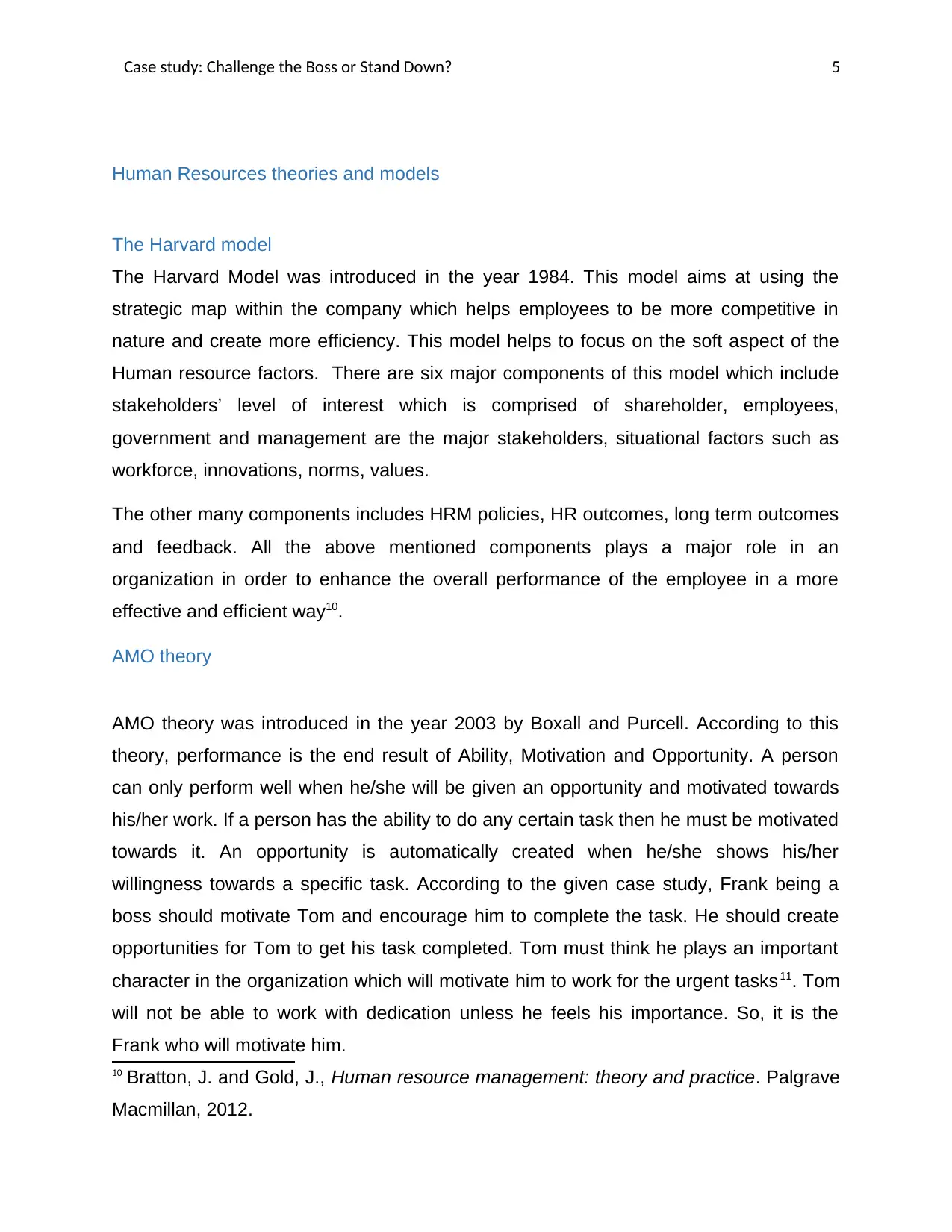
Case study: Challenge the Boss or Stand Down? 5
Human Resources theories and models
The Harvard model
The Harvard Model was introduced in the year 1984. This model aims at using the
strategic map within the company which helps employees to be more competitive in
nature and create more efficiency. This model helps to focus on the soft aspect of the
Human resource factors. There are six major components of this model which include
stakeholders’ level of interest which is comprised of shareholder, employees,
government and management are the major stakeholders, situational factors such as
workforce, innovations, norms, values.
The other many components includes HRM policies, HR outcomes, long term outcomes
and feedback. All the above mentioned components plays a major role in an
organization in order to enhance the overall performance of the employee in a more
effective and efficient way10.
AMO theory
AMO theory was introduced in the year 2003 by Boxall and Purcell. According to this
theory, performance is the end result of Ability, Motivation and Opportunity. A person
can only perform well when he/she will be given an opportunity and motivated towards
his/her work. If a person has the ability to do any certain task then he must be motivated
towards it. An opportunity is automatically created when he/she shows his/her
willingness towards a specific task. According to the given case study, Frank being a
boss should motivate Tom and encourage him to complete the task. He should create
opportunities for Tom to get his task completed. Tom must think he plays an important
character in the organization which will motivate him to work for the urgent tasks11. Tom
will not be able to work with dedication unless he feels his importance. So, it is the
Frank who will motivate him.
10 Bratton, J. and Gold, J., Human resource management: theory and practice. Palgrave
Macmillan, 2012.
Human Resources theories and models
The Harvard model
The Harvard Model was introduced in the year 1984. This model aims at using the
strategic map within the company which helps employees to be more competitive in
nature and create more efficiency. This model helps to focus on the soft aspect of the
Human resource factors. There are six major components of this model which include
stakeholders’ level of interest which is comprised of shareholder, employees,
government and management are the major stakeholders, situational factors such as
workforce, innovations, norms, values.
The other many components includes HRM policies, HR outcomes, long term outcomes
and feedback. All the above mentioned components plays a major role in an
organization in order to enhance the overall performance of the employee in a more
effective and efficient way10.
AMO theory
AMO theory was introduced in the year 2003 by Boxall and Purcell. According to this
theory, performance is the end result of Ability, Motivation and Opportunity. A person
can only perform well when he/she will be given an opportunity and motivated towards
his/her work. If a person has the ability to do any certain task then he must be motivated
towards it. An opportunity is automatically created when he/she shows his/her
willingness towards a specific task. According to the given case study, Frank being a
boss should motivate Tom and encourage him to complete the task. He should create
opportunities for Tom to get his task completed. Tom must think he plays an important
character in the organization which will motivate him to work for the urgent tasks11. Tom
will not be able to work with dedication unless he feels his importance. So, it is the
Frank who will motivate him.
10 Bratton, J. and Gold, J., Human resource management: theory and practice. Palgrave
Macmillan, 2012.
⊘ This is a preview!⊘
Do you want full access?
Subscribe today to unlock all pages.

Trusted by 1+ million students worldwide
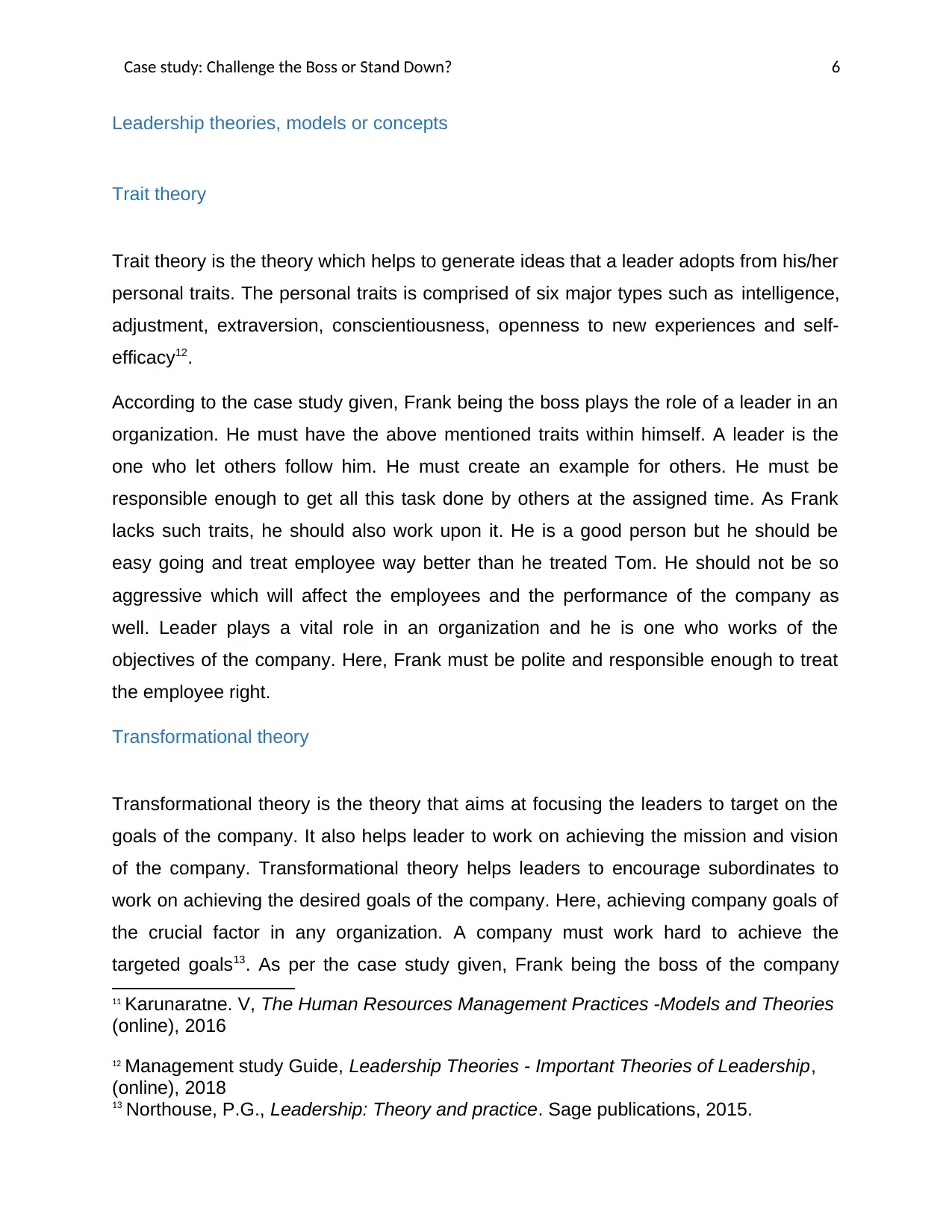
Case study: Challenge the Boss or Stand Down? 6
Leadership theories, models or concepts
Trait theory
Trait theory is the theory which helps to generate ideas that a leader adopts from his/her
personal traits. The personal traits is comprised of six major types such as intelligence,
adjustment, extraversion, conscientiousness, openness to new experiences and self-
efficacy12.
According to the case study given, Frank being the boss plays the role of a leader in an
organization. He must have the above mentioned traits within himself. A leader is the
one who let others follow him. He must create an example for others. He must be
responsible enough to get all this task done by others at the assigned time. As Frank
lacks such traits, he should also work upon it. He is a good person but he should be
easy going and treat employee way better than he treated Tom. He should not be so
aggressive which will affect the employees and the performance of the company as
well. Leader plays a vital role in an organization and he is one who works of the
objectives of the company. Here, Frank must be polite and responsible enough to treat
the employee right.
Transformational theory
Transformational theory is the theory that aims at focusing the leaders to target on the
goals of the company. It also helps leader to work on achieving the mission and vision
of the company. Transformational theory helps leaders to encourage subordinates to
work on achieving the desired goals of the company. Here, achieving company goals of
the crucial factor in any organization. A company must work hard to achieve the
targeted goals13. As per the case study given, Frank being the boss of the company
11 Karunaratne. V, The Human Resources Management Practices -Models and Theories
(online), 2016
12 Management study Guide, Leadership Theories - Important Theories of Leadership,
(online), 2018
13 Northouse, P.G., Leadership: Theory and practice. Sage publications, 2015.
Leadership theories, models or concepts
Trait theory
Trait theory is the theory which helps to generate ideas that a leader adopts from his/her
personal traits. The personal traits is comprised of six major types such as intelligence,
adjustment, extraversion, conscientiousness, openness to new experiences and self-
efficacy12.
According to the case study given, Frank being the boss plays the role of a leader in an
organization. He must have the above mentioned traits within himself. A leader is the
one who let others follow him. He must create an example for others. He must be
responsible enough to get all this task done by others at the assigned time. As Frank
lacks such traits, he should also work upon it. He is a good person but he should be
easy going and treat employee way better than he treated Tom. He should not be so
aggressive which will affect the employees and the performance of the company as
well. Leader plays a vital role in an organization and he is one who works of the
objectives of the company. Here, Frank must be polite and responsible enough to treat
the employee right.
Transformational theory
Transformational theory is the theory that aims at focusing the leaders to target on the
goals of the company. It also helps leader to work on achieving the mission and vision
of the company. Transformational theory helps leaders to encourage subordinates to
work on achieving the desired goals of the company. Here, achieving company goals of
the crucial factor in any organization. A company must work hard to achieve the
targeted goals13. As per the case study given, Frank being the boss of the company
11 Karunaratne. V, The Human Resources Management Practices -Models and Theories
(online), 2016
12 Management study Guide, Leadership Theories - Important Theories of Leadership,
(online), 2018
13 Northouse, P.G., Leadership: Theory and practice. Sage publications, 2015.
Paraphrase This Document
Need a fresh take? Get an instant paraphrase of this document with our AI Paraphraser
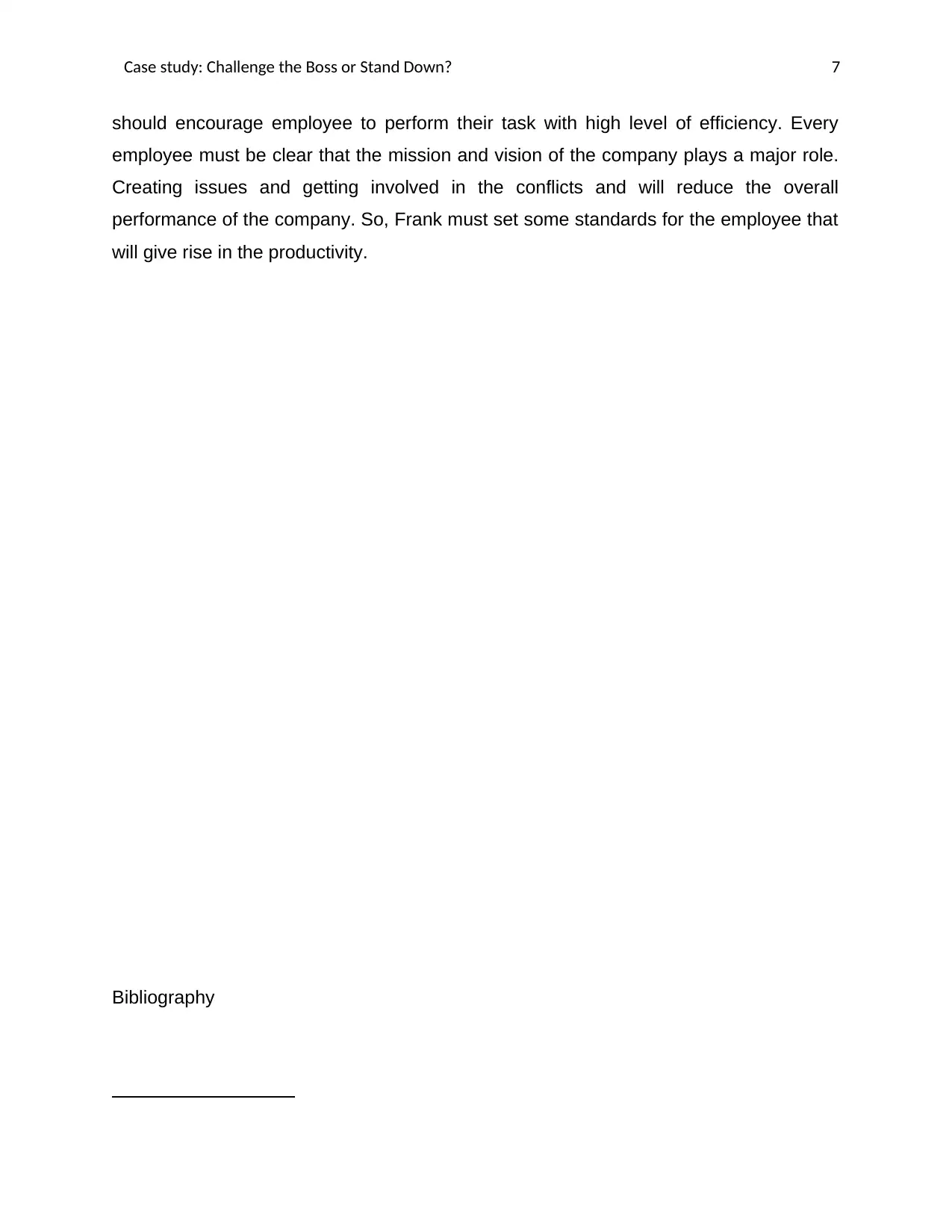
Case study: Challenge the Boss or Stand Down? 7
should encourage employee to perform their task with high level of efficiency. Every
employee must be clear that the mission and vision of the company plays a major role.
Creating issues and getting involved in the conflicts and will reduce the overall
performance of the company. So, Frank must set some standards for the employee that
will give rise in the productivity.
Bibliography
should encourage employee to perform their task with high level of efficiency. Every
employee must be clear that the mission and vision of the company plays a major role.
Creating issues and getting involved in the conflicts and will reduce the overall
performance of the company. So, Frank must set some standards for the employee that
will give rise in the productivity.
Bibliography
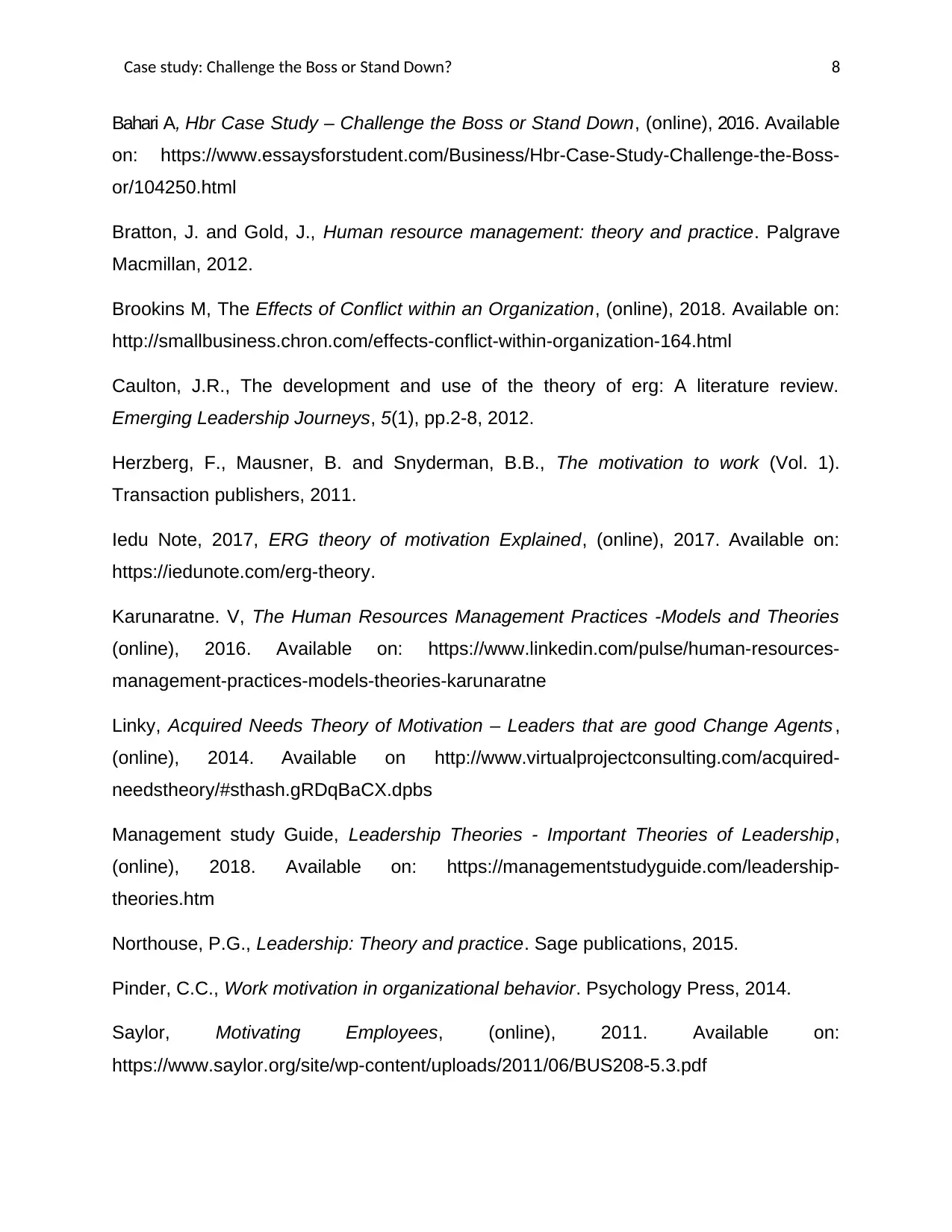
Case study: Challenge the Boss or Stand Down? 8
Bahari A, Hbr Case Study – Challenge the Boss or Stand Down, (online), 2016. Available
on: https://www.essaysforstudent.com/Business/Hbr-Case-Study-Challenge-the-Boss-
or/104250.html
Bratton, J. and Gold, J., Human resource management: theory and practice. Palgrave
Macmillan, 2012.
Brookins M, The Effects of Conflict within an Organization, (online), 2018. Available on:
http://smallbusiness.chron.com/effects-conflict-within-organization-164.html
Caulton, J.R., The development and use of the theory of erg: A literature review.
Emerging Leadership Journeys, 5(1), pp.2-8, 2012.
Herzberg, F., Mausner, B. and Snyderman, B.B., The motivation to work (Vol. 1).
Transaction publishers, 2011.
Iedu Note, 2017, ERG theory of motivation Explained, (online), 2017. Available on:
https://iedunote.com/erg-theory.
Karunaratne. V, The Human Resources Management Practices -Models and Theories
(online), 2016. Available on: https://www.linkedin.com/pulse/human-resources-
management-practices-models-theories-karunaratne
Linky, Acquired Needs Theory of Motivation – Leaders that are good Change Agents ,
(online), 2014. Available on http://www.virtualprojectconsulting.com/acquired-
needstheory/#sthash.gRDqBaCX.dpbs
Management study Guide, Leadership Theories - Important Theories of Leadership,
(online), 2018. Available on: https://managementstudyguide.com/leadership-
theories.htm
Northouse, P.G., Leadership: Theory and practice. Sage publications, 2015.
Pinder, C.C., Work motivation in organizational behavior. Psychology Press, 2014.
Saylor, Motivating Employees, (online), 2011. Available on:
https://www.saylor.org/site/wp-content/uploads/2011/06/BUS208-5.3.pdf
Bahari A, Hbr Case Study – Challenge the Boss or Stand Down, (online), 2016. Available
on: https://www.essaysforstudent.com/Business/Hbr-Case-Study-Challenge-the-Boss-
or/104250.html
Bratton, J. and Gold, J., Human resource management: theory and practice. Palgrave
Macmillan, 2012.
Brookins M, The Effects of Conflict within an Organization, (online), 2018. Available on:
http://smallbusiness.chron.com/effects-conflict-within-organization-164.html
Caulton, J.R., The development and use of the theory of erg: A literature review.
Emerging Leadership Journeys, 5(1), pp.2-8, 2012.
Herzberg, F., Mausner, B. and Snyderman, B.B., The motivation to work (Vol. 1).
Transaction publishers, 2011.
Iedu Note, 2017, ERG theory of motivation Explained, (online), 2017. Available on:
https://iedunote.com/erg-theory.
Karunaratne. V, The Human Resources Management Practices -Models and Theories
(online), 2016. Available on: https://www.linkedin.com/pulse/human-resources-
management-practices-models-theories-karunaratne
Linky, Acquired Needs Theory of Motivation – Leaders that are good Change Agents ,
(online), 2014. Available on http://www.virtualprojectconsulting.com/acquired-
needstheory/#sthash.gRDqBaCX.dpbs
Management study Guide, Leadership Theories - Important Theories of Leadership,
(online), 2018. Available on: https://managementstudyguide.com/leadership-
theories.htm
Northouse, P.G., Leadership: Theory and practice. Sage publications, 2015.
Pinder, C.C., Work motivation in organizational behavior. Psychology Press, 2014.
Saylor, Motivating Employees, (online), 2011. Available on:
https://www.saylor.org/site/wp-content/uploads/2011/06/BUS208-5.3.pdf
⊘ This is a preview!⊘
Do you want full access?
Subscribe today to unlock all pages.

Trusted by 1+ million students worldwide
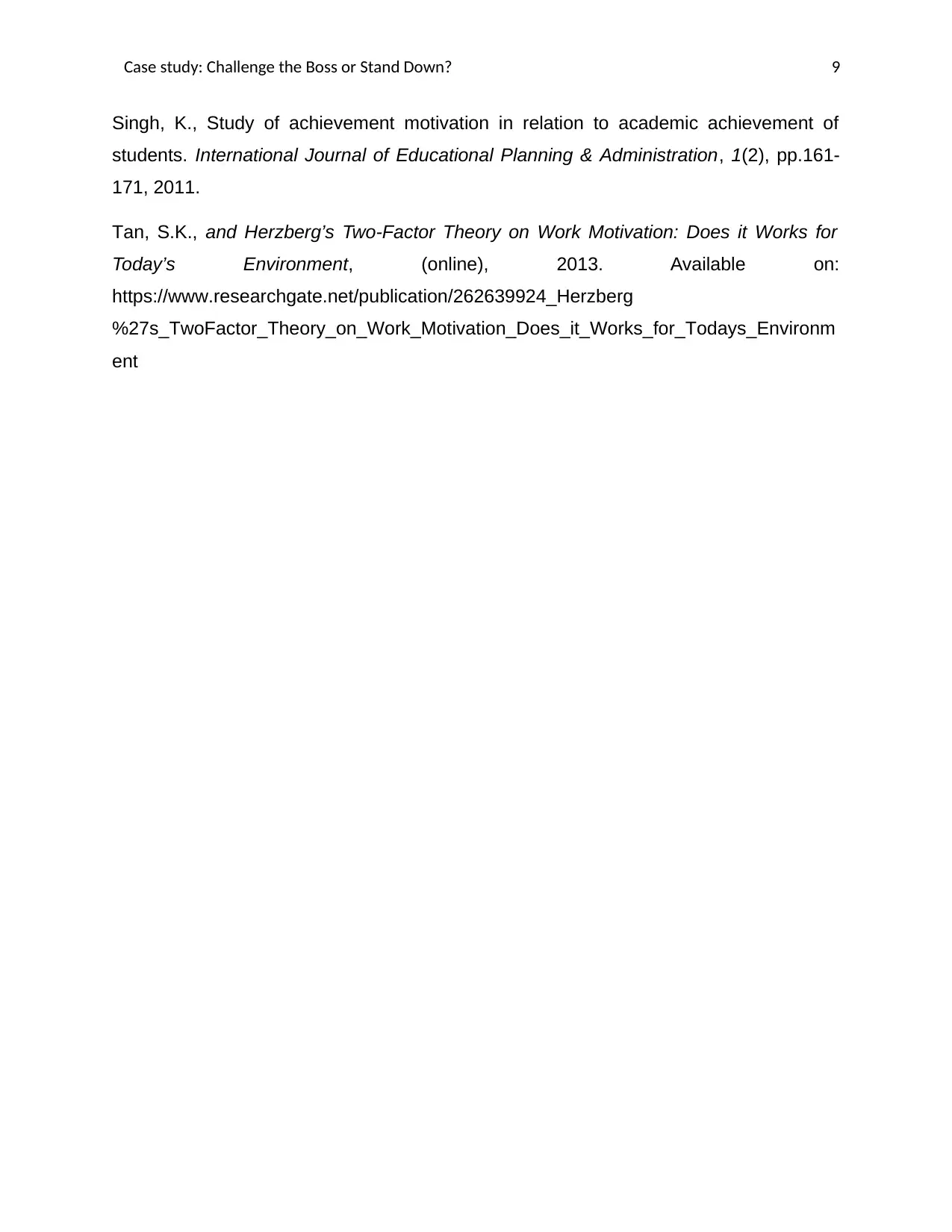
Case study: Challenge the Boss or Stand Down? 9
Singh, K., Study of achievement motivation in relation to academic achievement of
students. International Journal of Educational Planning & Administration, 1(2), pp.161-
171, 2011.
Tan, S.K., and Herzberg’s Two-Factor Theory on Work Motivation: Does it Works for
Today’s Environment, (online), 2013. Available on:
https://www.researchgate.net/publication/262639924_Herzberg
%27s_TwoFactor_Theory_on_Work_Motivation_Does_it_Works_for_Todays_Environm
ent
Singh, K., Study of achievement motivation in relation to academic achievement of
students. International Journal of Educational Planning & Administration, 1(2), pp.161-
171, 2011.
Tan, S.K., and Herzberg’s Two-Factor Theory on Work Motivation: Does it Works for
Today’s Environment, (online), 2013. Available on:
https://www.researchgate.net/publication/262639924_Herzberg
%27s_TwoFactor_Theory_on_Work_Motivation_Does_it_Works_for_Todays_Environm
ent
1 out of 10
Related Documents
Your All-in-One AI-Powered Toolkit for Academic Success.
+13062052269
info@desklib.com
Available 24*7 on WhatsApp / Email
![[object Object]](/_next/static/media/star-bottom.7253800d.svg)
Unlock your academic potential
Copyright © 2020–2025 A2Z Services. All Rights Reserved. Developed and managed by ZUCOL.




